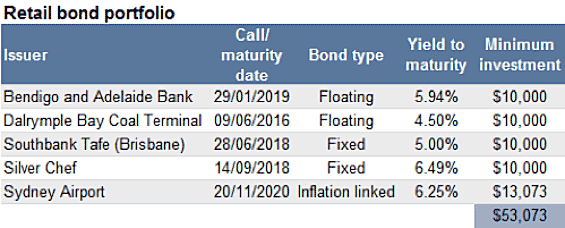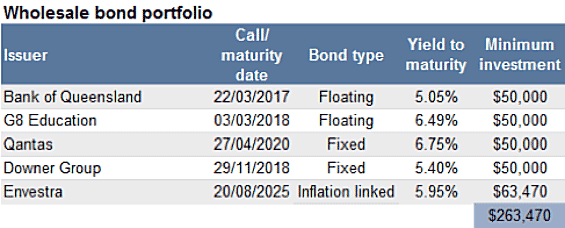While too few hold them, every investor should have an allocation to bonds given their higher income compared to term deposits and the unique protection they offer. For example, if you hold bonds to maturity, you know when interest will be paid to you and that capital will be repaid at maturity.
There are many strategies you can employ, but if you are uncertain about the direction of financial markets, a good start-up strategy is to have an allocation to each of the three types of bonds: fixed, floating and inflation-linked.
Fixed-rate bonds outperform as interest rates come down. They have an inverse relationship between yield and price, which should offset losses in other parts of your portfolio, such as property and equities, in a slowing economy.
If income is important to you, fixed-rate bonds will also protect your income stream as they pay defined half-yearly interest.
Conversely, if interest rates start to rise, higher interest will be captured by having an allocation to floating-rate bonds whose interest payments are linked to an underlying benchmark – usually the bank bill swap (BBSW) rate in Australia.
Interest payments are set at BBSW plus a margin. Quarterly interest payments will rise with higher interest rates.
Runaway growth can lead to an inflation spiral. In a slowing or bottoming economy, governments are under pressure to stimulate economic activity through direct or monetary policy intervention. If the government gets this wrong – overstimulates or stimulates for too long – upward inflationary pressures can result.
Holding an allocation to inflation-linked bonds (ILBs) makes sense before the risk of inflation heightens. ILBs can also be an excellent investment in a low-growth economy. Their known set margin above the consumer price index (CPI) can be attractive when interest rates are low for long periods.
The tables below show sample bond portfolios. The portfolios contain two fixed-rate bonds, two floating-rate bonds and one inflation-linked bond.
The retail portfolio shows five bonds with a minimum investment per bond of $10,000 – although the inflation-linked bond is higher, given its value has increased with inflation since it was first issued.
The yield to maturity shows the expected return if the bond is held until its expected maturity date. The retail portfolio’s yield to maturity is 5.68 per cent – a considerable boost over the best term deposit rates. The projected income for the next 12 months is $2940, roughly $735 per quarter.

Source: FIIG Securities
Note: prices accurate as at 17 March and subject to change
The wholesale portfolio also contains five bonds, but shows a higher minimum $50,000 per bond (although some wholesale bonds are also available from $10,000). It has a higher yield to maturity of 5.92 per cent. The expected income on this portfolio for the next 12 months is $15,242.
In two quarters, an investor’s income is approximately $2300 and in the other two quarters it is $5300. If you are able to show you are a wholesale investor there are a greater range of bonds available to you.

Source: FIIG Securities
Note: prices accurate as at 17 March and subject to change
There are many advantages to investing in bonds. Two other important features include: the more frequent payment of interest (floating-rate bonds and inflation-linked bonds generally pay quarterly interest, while fixed-rate bonds generally pay half yearly) and the fact bonds are tradeable securities, so investors can sell prior to maturity.
We can help you better understand Bonds and how they can work for you, in your wealth creation strategy. Call us today on 07 34210 0100 or email info@mywealthcare.com.au
This article was provided by Morningstar and FIIG Securities.




